Senior Editor
- FMA
- The Fabricator
- FABTECH
- Canadian Metalworking
Categories
- Additive Manufacturing
- Aluminum Welding
- Arc Welding
- Assembly and Joining
- Automation and Robotics
- Bending and Forming
- Consumables
- Cutting and Weld Prep
- Electric Vehicles
- En Español
- Finishing
- Hydroforming
- Laser Cutting
- Laser Welding
- Machining
- Manufacturing Software
- Materials Handling
- Metals/Materials
- Oxyfuel Cutting
- Plasma Cutting
- Power Tools
- Punching and Other Holemaking
- Roll Forming
- Safety
- Sawing
- Shearing
- Shop Management
- Testing and Measuring
- Tube and Pipe Fabrication
- Tube and Pipe Production
- Waterjet Cutting
Industry Directory
Webcasts
Podcasts
FAB 40
Advertise
Subscribe
Account Login
Search
The secret to success in metal fabrication: Keep it simple
Chattanooga custom fabricator overcomes the industry’s perennial challenge: its complexity
- By Tim Heston
- April 27, 2017
- Article
- Shop Management
Top quality and delivery gets a fabricator in customers’ doors. If a company can’t produce good parts on time, it’ll have a tough time growing let alone sustaining itself. The market has become just too competitive for mediocre performance.
So what causes quality and delivery problems? One answer is rework from bad parts, which is where operator skill enters the equation. In laser cutting this might be a nozzle that really isn’t centered, a focus point that really isn’t where it should be, a speed or feed that isn’t optimal, a cover slide (on fiber lasers) or focusing optic that really hasn’t been properly maintained or cleaned—the factors go on.
Modern equipment has automated a lot of these in-process quality assurance functions to varying degrees, depending on the tolerances and customer expectations. Some press brakes can even automatically correct angles to account for variations in material thickness, tensile strength, and grain direction.
But another element of the quality and delivery problem can rear its ugly head: the operational chaos indicative of high-product-mix manufacturing, up and down the process chain. Sales can agree to an order that really can’t be fulfilled. Expedites throw off the schedule. Machines cut parts that are already in inventory and skip parts that are needed and erroneously thought to be in inventory.
People scramble to set up machines but don’t pay attention to details. Alas, the cut blank reaches the press brake and it can’t be formed, thanks to out-of-tolerance dimensions that don’t take the proper bend deductions into account. How on earth did this make it through the system? It’s the usual suspect: the wrong drawing revision.
Bill Hewgley, founder and president of Metalworking Solutions, is all too familiar with the complexity of modern manufacturing. And when he launched his Chattanooga, Tenn., custom fabricator, he vowed to keep things simple. The result: Of all the pieces the company sent to customers in 2016, 99.8 percent of them met or exceeded quality expectations. How did the company accomplish this? By tackling the causes of the chaos, all of which can be boiled down to four categories: people, material, machinery, and company size.
Uncertain Beginnings
Hewgley took a huge leap of faith launching his business in 2006. For years he had managed a retail display fabrication division for a large manufacturer. He enjoyed a lot of success, in five years turning what was once a small division into the largest part of the entire business.
But he also endured the fiefdoms, the people with important-sounding job titles but no real job, the private equity buyout, and all the rest. “The corporate culture—the PowerPoints, the Excel sheets, the ‘let’s hold hands and cut $300,000 out of overhead by Friday, please,’ all that really didn’t recognize the people, the processes, and the vendors that provided the real value. It was all financial,” Hewgley said.
At 55, he decided to lay his cards on the table. He cashed out most of his lifetime savings to get the business off the ground. “I had no customers, no hot leads,” Hewgley recalled. “I just believed I could do it.”
He had a business plan stating that he wanted to become the FedEx of fabrication, borrowing its slogan: When it absolutely, positively has to be there—a good differentiator, considering on-time delivery in custom fabrication remains a continual challenge. The “2016 FMA Financial Ratios & Operational Benchmarking Survey” pegs average on-time delivery at 86 percent.

Metalworking Solutions’ floor has few racks and little WIP and finished-goods inventory. A few shrink-wrapped products are staged for immediate delivery near the shipping dock.
This all sounds nice, but when times are good, as they were in 2006, purchasers don’t always drop suppliers easily. It’s risky to change; the devil you know is better than the devil you don’t.
So those early days weren’t easy. Area customers were happy with their current supply base. As the new kid on the block, Metalworking Solutions couldn’t get its foot in the door. “Our first month we did $2,500 worth of work,” he said, “and my [loan] payments were $40,000. And at the worst of it, I was taking $40,000 a month out of my IRA to keep the company alive.”
During one sleepless night, he turned to his wife. At that point their savings had dwindled to two house payments’ worth, and they were living off his wife’s teacher’s pension. “Can you still love me if I’m wiped out at 57 years old?” he asked. His wife told him not to worry. She knew the circumstances wouldn’t get the best of Hewgley’s determination and tenacity. “She told me, ‘If you give it your best, you’ll make it.’”
Turns out she was right. The Great Recession hit, and in an ironic twist, as area fab shops suffered, things began looking up at Metalworking Solutions. Purchasers were scrutinizing their long-term relationships, and they could no longer overlook delivery and quality problems. Hewgley began getting his foot in the door to tell his story.
Laurence Richardson, vice president of operations, lived through this transition, joining the company in 2010. “Back then we had only $4 million in revenue. We’re on pace this year to make $14 million.”
People
Walk into the fabricator’s office and you don’t see rows of cubicles. You instead see a few people in a few offices and workspaces; you’ll also see, sitting next to windows facing the shop, a few people nesting parts or simulating a sequence in offline bend programming software (all the brakes on the floor can be programmed offline). But that’s about it. All told, the fabricator employs three administrators, three customer service personnel, and two production controllers. Add to that a few plant managers, programmers, and the quality assurance team, and you have the fabricator’s indirect labor force.
People wear many hats. The operations manager who handles the scheduling sometimes acts as sales manager for a few accounts. That person also buys material. There’s no dedicated purchasing manager to be found. No expediters either.
“When I started this business,” Hewgley said, “I wanted elegant simplicity. I wanted to take out all the noise. I run this business like a family farm. You never had one person dedicated to eggs, another to milking cows. Everybody just did what needed to be done.”
You also won’t see anybody in human resources. Instead, the company outsources benefits, payroll, and other employee management tasks to a professional employer organization (PEO) called Insperity—a move the shop made after it reached 50 employees and had to deal with Affordable Care Act compliance. Worker paychecks don’t come from Metalworking Solutions but instead directly from Insperity.
“I’m paying less for that service than I would hiring one person who really wouldn’t have a full-time job,” Hewgley said.
PEOs group small companies together to give them buying power. Alone, the fabricator wouldn’t have much room to negotiate with insurers. But through a PEO, Metalworking Solutions can offer similar benefits to those offered by FORTUNE® 500 firms.
Most significant for Hewgley’s strategy, the PEO allows Metalworking Solutions to maintain a very small indirect labor force. Every one of the office’s 11 salaried professionals focuses on product quality, delivery, and customer service.
Material
On a typical busy day, Metalworking Solutions’ shop floor looks surprisingly empty—not much raw stock, work-in-process, or finished goods. There aren’t many racks, and the ones they do have are devoted to raw material, not WIP or finished goods.
“We don’t make anything to stock, and we don’t warehouse anything,” Richardson said. “Everything is made to order. And nothing is cut until we can do something with it and send it out the door.”
The day of my visit, Hewgley had just come back from inspecting the progress of an adjacent warehouse the fabricator is building, but it won’t be for raw stock the shop owns. Instead, he’s holding the material on consignment. That started after the fabricator processed enough consistent volume of work to be able to negotiate an agreement with its service center, forecast material demand, and commit to it for a certain amount per quarter. This was in 2015, when the fabricator was about a $10 million operation.
The company doesn’t own any of its raw stock, save a few remnants, until someone cuts a metal strap surrounding a batch of sheets. A representative from the material supplier stops by the fabricator twice a month to count stock and bill the company for what it used.
On average, it takes about 18 days for jobs to make their way through the plant. That’s an average, though. A few projects take several months, and quite a few take a matter of days. Some flow so fast that the fabricator receives payment for a job before it is even billed for the material.
The company turns its inventory more than 70 times a year, far more than the industry average (according to a recent FMA benchmarking survey) of fewer than 10 turns annually. And at the end of 2016 it had just $150,000 in inventory, which isn’t much for a $12 million business.
“Inventory is not like fine Italian red wine,” Hewgley said. “It does not get better with age.”
“Two weeks is an eternity in our business. We’re able to react quickly as orders come in, but we don’t have cash and capital tied up in them,” Richardson added. “Consignment inventory allows us to turn jobs quicker without having inventory we own on the floor.”

Vice President of Operations Laurence Richardson (left) and Executive Vice President Nick Burrows stand by the company’s new automated punch press.
The company accomplishes this successfully even without having in-house powder coating. “We have a great custom coater 10 minutes up the road,” said Nick Burrows, executive vice president and general manager. “They’re ISO certified, and we have a great relationship. We know their schedule, and they have a spray-to-waste booth to do small batches and first articles. They’re very consistent on the turnaround.”
Richardson added that the company does send some jobs out for plating, and the turnaround times can vary, but it’s a small percentage of the fabricator’s part mix.
This positive cash flow model pleases accountants and investors, but what about the employees on the shop floor? The focus on velocity helps simplify operations and scheduling. When it comes to nesting, programmers don’t concentrate on material utilization all the time, though they use as much material as they can if the jobs allow for it.
Hewgley and his team also don’t concentrate on remnant utilization. Sure, the shop keeps some on hand—a small enough amount so that it’s easy to track and use, but not too much. “Sometimes you end up in a situation where you’re spending more money carefully tracking your remnants than you would just throwing the remnant in the scrap bin,” Burrows said. “You spend more than the benefit you get for the effort. Sure, I saved a little remnant material, but I just spent half a person’s salary trying to track it. What did I really save?”
Simplicity is the goal, so simple that the shop doesn’t use its ERP system to track and manage material as it moves through the shop. Scheduling has become even simpler as the fabricator continues to take on more repeat orders, which have known processing times. Jobs are pulled to the floor based on due date and immediate demand expectations.
For instance, if a large order is expected the next day, production managers may release another order a day early, just to clear the deck for what’s to come. “And 90 percent or more of our customers will take orders early,” Richardson said. “If we finish it, we ship it. We don’t hold finished-goods inventory.” He added that the company does not release orders just to increase material utilization a little, or increase equipment green-light-on time (as explained later).
How do people know what to work on next? They just look at the few job travelers in front of them. They don’t have piles of WIP to sift through. If it’s on the floor, operators and welders need to process it soon. Otherwise, it wouldn’t have been released in the first place.
The materials portion of the business model has another important aspect: collections. Sky-high inventory turns can’t produce cash flow if customers don’t pay on time. To that end, the fabricator buys credit insurance.
“They’re our credit department,” Burrows said, adding that the insurer analyzes the creditworthiness of new customers. If a customer defaults on a payment, the credit insurer pays Metalworking Solutions the money. This of course gives the insurer a vested interest to vet new customers and scrutinize their creditworthiness. Since the fabricator launched, only one customer has defaulted on payment—but the shop still got its money.
Buying insurance comes at a cost, including deductibles and premiums, but these are costs the fabricator can predict. Moreover, it prevents the fabricator from basically being a bank and offering what are in effect short-term loans every time customers fail to pay on time. Most important, it keeps the fabricator’s cash flow healthy.
Machinery
Part of Hewgley’s strategy was to launch Metalworking Solutions with new equipment and continue investing to ensure the shop could maintain or increase the part flow velocity.
“Even our oldest laser is just 10 years old,” Burrows said.
The shop has redundancy built in, with similar machines and cross-trained personnel. If someone calls in sick or a machine unexpectedly hiccups or falters, jobs continue to flow.
The shop has automated laser systems with material handling towers, a press brake with automated tool change, and a punch press with automated part removal, all from Amada. Welding is at the far end of the 75,000-square-feet facility, and an area for light assembly work is adjacent to the shipping dock.
Considering the company’s focus on part flow velocity, several areas stand out as somewhat counterintuitive. One has two manual offloading tables next to two automated laser systems. Another has a turret punch press with automated part removal and skeleton management. Then, when you see the shop in action, the aha! moment arrives.
Determining if laser cutting automation is a good fit isn’t always straightforward. If workers can load sheets and offload parts faster than the cutting cycle time, and the laser is never waiting for material, why invest in a tower? You then employ a team of people that spend their days shaking out a big pile of parts.
Sure, if a shop cuts only thin stock—especially considering the capabilities of modern fiber lasers—material handlers simply cannot keep up with it. But cutting cycle time varies depending on material thickness and the part geometries in a nest, and custom shops like Metalworking Solutions don’t cut just thin material.
Hence the shop’s manual offloading tables adjacent to its towers. If the laser cuts a nest that workers can unload faster than the laser cutting cycle time, and the job is needed immediately downstream, it is shuttled to the manual offload table.
The company has mirrored this arrangement on an adjacent machine. So now, one or (at most) two workers manage two offloading tables between the automated towers, a newer fiber system on the left and an older CO2 system on the right.
If workers can’t keep up with the machines, or if the machines run unattended over a weekend, the material handling automation shuttles cut nests into the tower for later offloading and sorting.
Of course, a team still needs to shake out parts after a laser has run unattended overnight or over a weekend. But shaking sheets and sorting parts in the morning is faster (not to mention makes smarter use of cutting capacity) than having to laser cut those jobs during a shift.
Similar thinking went into the recent investment in turret punch press automation. The machine removes parts automatically using a parts picker that lifts punched parts out of the nest as they’re completed. The punch tools process about 90 percent of the nest. The picker then moves in to retrieve pieces as the punch removes the final tabs holding the pieces in the nest, releasing the part. Once the sheet is finished, it unloads the skeleton and loads the next sheet. All this slows the punching cycle time.
All the same, automated part and skeleton removal means the punch machine can run unattended. “Since yesterday afternoon there has not been a soul over here running this machine,” Richardson said. “My second-shift operator told me that he literally never came over here [by the punch] all night.”
In some cases, one operator sets up the punch machine for a shift (or more), then spends the rest of his day operating an adjacent laser. The outcome is that throughout the day parts flow downstream from both the punch and laser.
But again, custom fabrication is rife with demand variation. Some days the operator may look at the schedule and see a lot of punched parts that need to be delivered downstream or shipped immediately. In these cases, the machine punches at full speed, and parts are offloaded and sorted manually.
Although the shop looks to get the most out of its machines when it needs to, it doesn’t cut or bend parts just to push them through, though people do debate this now and then. It all hinges on downstream demand.
As Richardson recalled, “When we installed the automated punch press, the first thing on the operators’ minds was this: They wanted to skip the automation and pile up the work in shaker sheets, so they could go on to the next job. But we don’t need the next job now, and you’re going to create a mountain of stuff that will take two people an entire shift to go through and shake out. Why would we do that? And if you go on to the next job, that’s going to pile up somewhere too. With the automation, we can take it straight to the press brake.”
“We can’t form these parts faster than this machine can punch it,” Burrows added, “and the welders are several days away from needing the work.”
This flow philosophy is one reason that you don’t see a bunch of charts in the shop tracking overall equipment effectiveness (OEE), green-light-on time, and other metrics. In fact, it’s Hewgley’s philosophy to not spend much time and resources tracking such things, because he feels all that data adds to complexity. After all, a part mix one day may be completely different the next day, so yesterday’s metrics aren’t really that useful. It’s more useful to observe operations, talk to operators, and apply a little common sense (the part offloading strategy is a prime example). He added that sometimes continually poring over data prevents managers from seeing the forest for the trees.
Burrows added that it’s about the speed at which a job flows through the plant, not how quickly a machine produces a job. “We’re more concerned about velocity. You take metal, you add some value to it, and you ship it as fast as you can.”

In this arrangement, manual offload tables are used when cutting cycle times do not exceed the time it takes to remove parts from a nest. If cutting cycle times are shorter, or if the machines run lights-out, cut parts are shuttled into the tower for later removal.
As Hewgley explained, customers don’t care about machine uptime, OEE, or other traditional efficiency metrics. But they do care about on-time delivery of parts that meet or exceed quality requirements (at this writing it exceeds 95 percent), and that the fabricator does track religiously. It also tracks inventory turns to ensure good cash flow.
Finally, the fabricator tracks sales per employee, factoring in material costs and other purchased components and services. If sales per employee is high and material cost is low, the profit comes, as does the promise of secure employment and future opportunity for the company’s workers. At this writing, Metalworking Solutions enjoys more than $200,000 in sales per employee (thanks in large part to automation), and its material costs remain less than 30 percent of sales. With these numbers, who really cares if a sheet nest has some empty space now and then?
Company Size
This business model does have one limitation: It’s not scalable, at least not in the traditional sense. Metalworking Solutions now has about 60 employees, and Hewgley said he doesn’t have plans to grow the head count in Chattanooga much larger than 100.
“In my years in business, I’ve seen it happen many times,” Hewgley said. “Whenever you surpass around 100 people, you have people separate out into little tribes—the operations tribe, the accounting tribe, the purchasing tribe, the production tribe. And then these tribes start shooting arrows at each other, which breaks down communication, and you have duplication of efforts.”
The company fabricates enough material so it can pursue advantageous purchasing strategies, like material consignment agreements. (The company shipped 500 tons of material in January.) It also is large enough so customers can rely on the fabricator for repeat orders. These jobs may have parts delivered in kits, which require small batches and frequent job changeovers, hence the benefit of machines like the press brake with automatic tool changes (an investment that has allowed the shop to have fewer press brakes for every blanking machine). But every job isn’t brand new, which again maintains the shop’s core strategy: keep things simple.
“This also helped mitigate the feast-and-famine nature of a lot of fabrication work,” Hewgley explained, adding that years ago the company concentrated mainly on that one-off, project-type work that comes in irregular, unpredictable intervals. Machines were overloaded one week then had capacity to spare the next. Today more than 65 percent of the company’s work is for product lines that need parts on a regular basis.
But if Metalworking Solutions accepted a huge project requiring large volumes, it would have no choice but to grow and perhaps become more departmentalized and, in Hewgley’s view, more politicized. At previous companies Hewgley felt that the fiefdoms, often created by unneeded hierarchy and bureaucracy, ruined the culture. In fact, some managers with big-sounding titles had just one or two direct reports, and it wasn’t clear exactly what value those senior (usually expensive) managers provided.
As Hewgley put it, “At these larger companies, I found that about 50 percent of the workforce had about 50 percent of a job. That’s how you get some organizations where their ratio of direct-to-indirect labor is 1-to-1. We’re 4-to-1. That’s where you make your money. You need people who are actually making the things that customers will buy.”
The bureaucracy and hierarchy came as a reaction to control complexity as the company grew. So why not keep it small and simple? For this reason, the company has turned down offers for certain large, multimillion-dollar contracts. In the short term, the growth would require the company to invest in more people and equipment and, to support those investments, become too reliant on a single source of revenue.
In the long term such large contracts, fabricated in a single location, would increase operational complexity. Although such large contracts may be the strength of some of the country’s largest contract fabricators—many of which have made big strides in software and data management to handle all the complexity—that’s not Metalworking Solutions’ sandbox.
As Burrows explained, the fabricator’s sandbox includes jobs larger than one-off or small-volume job shop work, but it doesn’t include massive contracts from large OEMs either. The sweet spot is in between those two extremes.
“When you get right down to it,” Burrows said, “we’re just trying to protect our culture and our capital.”
Yet the fabricator still has plans to grow, just not in the typical way. In the future, Hewgley sees the company opening regional, quick-turn fabrication centers in different areas of the country. Each would operate independently, but fabricate the Metalworking Solutions way. It would be almost like a franchise operation, minus the franchise ownership model.
“We want to grow,” Burrows added. “But we don’t want individual locations to get much larger than between 75 and 100 employees.” He added that once revenue grows to between $17 million and $20 million in Chattanooga, “that will be the catalyst for us to start looking at opening other locations.”
A Four-legged Stool
What is “the Metalworking Solutions way,” exactly? It isn’t just about quick-turn fabrication. After all, that’s what most custom fabricators promise. It instead involves four legs of a stool: a small operation at each location; a lean staff without rigid job descriptions; modern, productive equipment; and a material strategy that includes rapid turns and minimal inventory. Secure all four legs, and you build the foundation for a sustainable business.
Metalworking Solutions, 423-648-6980, www.metalworkingsolutions.com
About the Author

Tim Heston
2135 Point Blvd
Elgin, IL 60123
815-381-1314
Tim Heston, The Fabricator's senior editor, has covered the metal fabrication industry since 1998, starting his career at the American Welding Society's Welding Journal. Since then he has covered the full range of metal fabrication processes, from stamping, bending, and cutting to grinding and polishing. He joined The Fabricator's staff in October 2007.
Related Companies
subscribe now

The Fabricator is North America's leading magazine for the metal forming and fabricating industry. The magazine delivers the news, technical articles, and case histories that enable fabricators to do their jobs more efficiently. The Fabricator has served the industry since 1970.
start your free subscription- Stay connected from anywhere

Easily access valuable industry resources now with full access to the digital edition of The Fabricator.

Easily access valuable industry resources now with full access to the digital edition of The Welder.

Easily access valuable industry resources now with full access to the digital edition of The Tube and Pipe Journal.
- Podcasting
- Podcast:
- The Fabricator Podcast
- Published:
- 04/16/2024
- Running Time:
- 63:29
In this episode of The Fabricator Podcast, Caleb Chamberlain, co-founder and CEO of OSH Cut, discusses his company’s...
- Trending Articles
AI, machine learning, and the future of metal fabrication

Employee ownership: The best way to ensure engagement

Steel industry reacts to Nucor’s new weekly published HRC price

Dynamic Metal blossoms with each passing year

Metal fabrication management: A guide for new supervisors

- Industry Events
16th Annual Safety Conference
- April 30 - May 1, 2024
- Elgin,
Pipe and Tube Conference
- May 21 - 22, 2024
- Omaha, NE
World-Class Roll Forming Workshop
- June 5 - 6, 2024
- Louisville, KY
Advanced Laser Application Workshop
- June 25 - 27, 2024
- Novi, MI






























